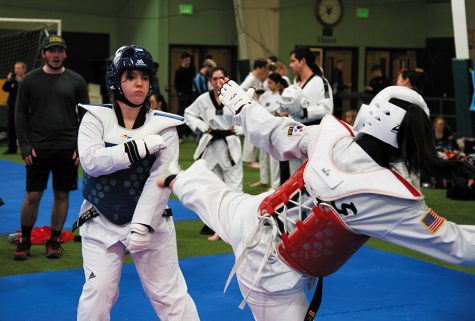Taekwondo club hosts tournament in Vermont
April 11, 2019

Personal expression through a painting, a song or a sculpture is only one form of art. For a group of 14 UVM students, they think differently, and embrace martial arts.
The UVM Taekwondo club hosted its sixth tournament April 7 at Patrick Gym for the Eastern Collegiate Taekwondo Conference.
The tournament included competitors from other colleges in the Northeast, including Cornell University and the United States Military Academy West Point. UVM had 13 students compete in the tournament.
The UVM Taekwondo club includes students with a range of skill levels, from beginner to master, club trainer Ernest Hart ’95 said.
“We’ve had people come in with no experience, and we’ve had people come in having done it their whole lives,” he said. “Anyone can join.”
First-year Sara Music said she fell in love with taekwondo five years ago in a South Burlington gym.
“People are fighting, but they aren’t mean about it,” she said. “It gets you exhilarated.”
First-year Suzanna Hamal had a martial arts background before coming to UVM.
Hamal said that one of the reasons she joined the team was because she enjoyed working out, which she does on her off-days.
The tournament is comprised of two sections. The first is a “poomsae” competition, in which individuals perform different poses and forms. The second half of the tournament is sparring, which is the hand-to-hand combat part, club president Katy Czar, a senior, said.
“We start at 9 a.m. and then go until the sparring is over, which is usually around 5 p.m. or 6 p.m.,” she said. “We usually do poomsae in the morning, and then our sparring in the afternoon.”
The scoring of the poomsae part of the competition is based on criteria within the accuracy and presentation categories, according to the USA Taekwondo competition rules.
Competitors can earn a maximum of four points in the accuracy category and six points in the presentation category, making for a combined maximum of 10 points, according to USATKD competition rules.
“For [accuracy], it’s about having correct stance, all the right motions, having your fist in the right place after you punch. It can get really minute,” Czar said. “Presentation is about rhythm, timing and how ‘taekwondo-y’ it is.”
The sparring score is based on the number and types of hits used in the match. These hits are scored as points and the winner of the match advances in the competition as depicted on the bracket, she said.
The competitor who has the most points at the end is the winner, Czar said.
According to the USATKD competition rules, valid hits are scored from one to five points, based on the complexity of the move.
For example, a turning kick to the head is worth five points, where a standard punch to the body is worth one point, according to the USATKD competition rules.
Two fighters spar for three rounds. The sparring winner is determined by who has the most points at the end.
“We have brackets, but the way we do it is that we have three-person teams in separate divisions,” she said. “The teams fight best two-out-of-three.”
At the end of the tournament, the winning team is the one with the most points.
Hart said that his favorite part of the team is the comradery.
“Everybody has got each other’s back,” he said. “It’s not just about the hour of practice, and then everybody disperses. That’s why, when we get people, they tend to stay.”
Free taekwondo classes are available to UVM students at various times throughout the week during the academic year., according to the Taekwondo Club Lynx page.






